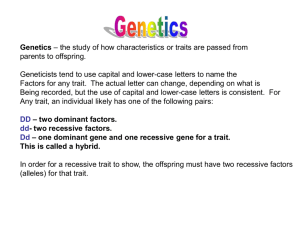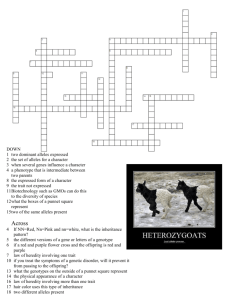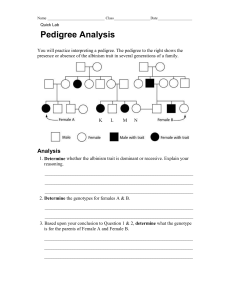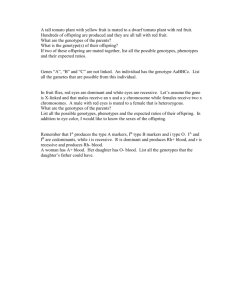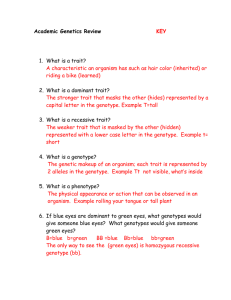Genetics Problems: Monohybrid & Dihybrid Crosses Worksheet
advertisement
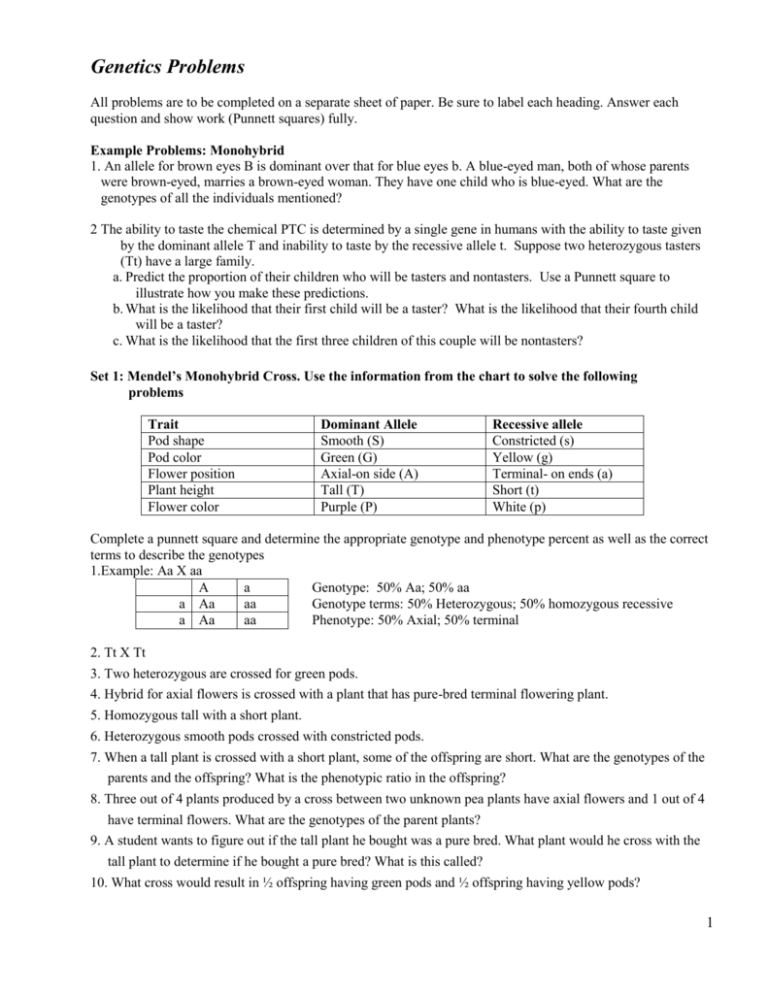
Genetics Problems All problems are to be completed on a separate sheet of paper. Be sure to label each heading. Answer each question and show work (Punnett squares) fully. Example Problems: Monohybrid 1. An allele for brown eyes B is dominant over that for blue eyes b. A blue-eyed man, both of whose parents were brown-eyed, marries a brown-eyed woman. They have one child who is blue-eyed. What are the genotypes of all the individuals mentioned? 2 The ability to taste the chemical PTC is determined by a single gene in humans with the ability to taste given by the dominant allele T and inability to taste by the recessive allele t. Suppose two heterozygous tasters (Tt) have a large family. a. Predict the proportion of their children who will be tasters and nontasters. Use a Punnett square to illustrate how you make these predictions. b. What is the likelihood that their first child will be a taster? What is the likelihood that their fourth child will be a taster? c. What is the likelihood that the first three children of this couple will be nontasters? Set 1: Mendel’s Monohybrid Cross. Use the information from the chart to solve the following problems Trait Pod shape Pod color Flower position Plant height Flower color Dominant Allele Smooth (S) Green (G) Axial-on side (A) Tall (T) Purple (P) Recessive allele Constricted (s) Yellow (g) Terminal- on ends (a) Short (t) White (p) Complete a punnett square and determine the appropriate genotype and phenotype percent as well as the correct terms to describe the genotypes 1.Example: Aa X aa A a Genotype: 50% Aa; 50% aa a Aa aa Genotype terms: 50% Heterozygous; 50% homozygous recessive a Aa aa Phenotype: 50% Axial; 50% terminal 2. Tt X Tt 3. Two heterozygous are crossed for green pods. 4. Hybrid for axial flowers is crossed with a plant that has pure-bred terminal flowering plant. 5. Homozygous tall with a short plant. 6. Heterozygous smooth pods crossed with constricted pods. 7. When a tall plant is crossed with a short plant, some of the offspring are short. What are the genotypes of the parents and the offspring? What is the phenotypic ratio in the offspring? 8. Three out of 4 plants produced by a cross between two unknown pea plants have axial flowers and 1 out of 4 have terminal flowers. What are the genotypes of the parent plants? 9. A student wants to figure out if the tall plant he bought was a pure bred. What plant would he cross with the tall plant to determine if he bought a pure bred? What is this called? 10. What cross would result in ½ offspring having green pods and ½ offspring having yellow pods? 1 Set 2: Monohybrid Practice (dominant/recessive) 1.A green pea plant (Gg) is crossed with a yellow pea plant (gg). 2. A true breeding tall plant is crossed with a hybrid tall plant. 3. A heterozygous tall plant is crossed with a short plant. 4. A hybrid red flower (Rr) is crossed with a white flower (rr). 5. If red is dominant (R) and white is recessive (r) what are the parents if 100% of the offspring are white? . 6. If black (B) is dominant and brown is recessive (b) what are the parents if all the chicks are black colored? 7.A homozygous dominant brown mouse is crossed with a heterozygous brown mouse (tan is the recessive color). What are the phenotypic ratios of the offspring? 8.Two heterozygous white (brown fur is recessive) rabbits are crossed. What are the ratios for all possible genotypes & phenotypes? 9.Two heterozygous red flowers (white flowers are recessive) are crossed. Is it possible to get all red flowers? Is it probable to get all red flowers? 10.A cross between two plants yields 68 tall plants and 36 short plants. What are the probable genotypes of the parents? Why? 11.A heterozygous white rabbit is crossed with a homozygous black rabbit. What are the genotypic and phenotypic types and ratios? Set 3: Probability Practice 1.In humans, curly hair (H) is dominant over straight hair. A heterozygous woman for hair curl marries a man with straight hair and they have children. a. What is the genotype of the parents and what gametes can they produce? b. What is the probability that the first child will have curly hair? The second child? c. What is the probability that three children in a row will have curly hair? 2.List all the gametes that are possible with each of the following genotypes. a) Aabb b) AaBB c)AaBb d)AABb 3.What is the probability of getting the gamete [st] from each of the following parents? a) Sstt b) ssTt c) SsTt d) SStt 4.In a certain strain of mice, black coat (B) is dominant over white coat (b). Describe what you would do to determine the genotype of a male with a black coat and how would this enable you to choose between the genotypes BB or Bb. 5. What is the probability of each of the following sets of parents producing the given genotypes in their offspring? Parents Genotype Offspring Genotype a) Tt x Tt Tt b) Tt x tt Tt c) SsTt x SsTT SSTT d) SsTt x SSTt sstt 2 6. In humans, the allele for albinism (lack of pigment) is recessive to the allele for normal skin pigmentation(N). a) If two heterozygous parents have children what is the chance the child will be albino? b) If the child is normal, what is the chance that it is a carrier (heterozygous for the albino allele? c) If normal parents have an albino child, what is the probability that their next child will be normal for pigment? Set 4: Calculations based on Generations 1. In tomatoes the texture of the skin may be smooth or peach (hairy). The Ponderosa variety has fruits with smooth texture. The red peach variety has fruits with peach texture. Crosses between the two varieties produce all smooth fruits. Crosses between these smooth fruited F1 plants produced 174 peach textured fruits and 520 smooth textured fruits. How are these skin textures inherited? 2. A brown mouse is mated is mated with two female black mice. When each female has produced several litters of young, the first female has had 48 black and the second female has had 14 black and 11 brown young. Deduce the pattern of inheritance of coat color and the genotypes of all of the parents. *3. Two varieties of wild daisies are ordered by a florist. The first variety is white and has thin petals. The second variety is yellow and has broad petals. Both varieties are true-breeding. The florist plants each variety on opposite ends of a garden plot in front of her store. The following year she has mostly white daisies with broad petals in the plot. Explain what most likely occurred. (assume both traits are dominant/recessive). Could she get the original flower types back with the current white, broad petal daisies – explain in terms of probabilities? Example Problem: Dihybrid Cross In pepper plants, green (G) fruit color is dominant to red (g) and round (R) fruit shape is dominant to square (r) fruit shape. These two genes are located on different chromosomes. a. What gamete types will be produced by a heterozygous green, round plant? b. If two such heterozygous plants are crossed, what genotypes and phenotypes will be seen in the offspring and in what proportions? Set 5: Dihybrid Crosses 1.Two hybrid (heterozygous) pea plants for pod color and pod shape are crossed (see page one chart). What are the genotypic and phenotypic ratios in the offspring? What is the phenotype of the parents in this cross? 2.Mice running normally is dominant (R) while mice which run in circles (called waltzing) is recessive. Mice which have black hair are dominant (B) while having brown hair is recessive. If a homozygous running, black mouse is crossed with a homozygous waltzing, brown mouse – what are the phenotypic and genotypic ratios of the offspring? What are the genotypes of the parents? 3.In rabbits, gray fur (G) is dominant to white fur. Also in rabbits, black eyes (B) are dominant to red eyes. A male rabbit that is homozygous grey hair, homozygous red eyed is crossed with a female rabbit that has white fur with heterozygous black eyes. 3 *4. A male and female rabbit (same traits and alleles as in #3) have 3 separate litters. Determine average the ratio of the 4 possible phenotypes for each litter based on the given table. Litter number 1 2 3 Ratio Gray fur, black eyed 10 14 5 Gray fur, red eyed 4 5 2 White fur, black eyes 3 5 2 White fur, red eyed 1 2 0 Based on the calculated ratio – what would the genotypes of the parents be? Explain. 5. An aquatic arthropod called a Cyclops has antennae that are either smooth or barbed. The allele for barbs (B) is dominant. In the same organism, resistance to pesticides is a recessive trait (P). A Cyclops that is resistant to pesticides and has smooth antennae is crossed with one that is heterozygous for both traits. What is the percent of the offspring will be resistant to pesticides? Example Problem: Incomplete Dominance A hybrid pink CRCW snapdragon was crossed with a pure white one CWCW. Red flower color is incompletely dominant. a.Make a Punnett square and list the genotypic and phenotypic ratios of the F1 generation Set 6: Incomplete Dominance 1.Suppose you have two rose plants, both with pink flowers. You cross the two plants and are surprised to find that, while most of the offspring are pink, some are red and some are white. You decide that you like the red flowers and would like to make more. What cross would you perform to produce the most red flowered plants? Your mother decides she would like some of the pink flowered roses. Which cross would give you the most pink flowered plants? 2. A naturalist visiting an island in the middle of a large lake observes a species of small bird with three distinct types of beaks. Those with short, crushing beaks (BB) consume hard shelled nuts, those with long, delicate beaks (bb) pick the seeds from pine cones, and those with intermediate beaks (Bb), consume both types of seeds though they are not as good at either. Which of the mated pairs will have the best adapted offspring in a year in which most of the food available is in the form of hard shelled nuts? Which of the mated pairs will have the best adapted offspring to a diverse food supply? 3. In northeast Kansas there is a creature know as a wildcat. It comes in three colors, black (B), gray, and white (W). This trait is controlled by a single gene with incomplete dominance. What would be the genotypes and phenotypes of the offspring if a black wildcat were crossed with a gray one? 4. Coat color in mice is incompletely dominant. Yellow and white-colored mice are homozygous, while creamcolored mice are heterozygous. If two cream-colored mice mate, what phenotypic ratio can we expect of their offspring? 5. In radishes, red and white are pure-breeding colors, while hybrids are purple. If a red radish is crossed with a white radish, what will be the phenotype of the F2 generation (assuming the F1 generation self-pollinates)? Show the Punnett Square. 4 Example Problem: Codominance / Multiple Alleles A,B,O Blood system. A person's blood type with respect to the ABO blood system is a multiple allele system where the person's blood type is determined by which two autosomal alleles from the set IA, IB or i an individual has. Paul is blood type O. His father is blood type A and his mother is blood type B. What are the genotypes of his parents? What are the possible phenotypes Paul’s brother? Set 7: Codominance / Multiple Alleles Human blood types genotypes can be expressed the following ways. Phenotype (Blood type) O – universal donor A B AB + universal receiver Genotype ii IAIA or IAi IBIB or IBi IAIB 1.Suppose a father of blood type AB and a mother of blood type B have a child of type B. What blood types are possible in their subsequent children? 2.Suppose a child is of blood type A and the mother is of type O. What type or types may the father belong to? 3.Suppose a father and mother claim they have been given the wrong baby at the hospital. Both parents are blood type A. The baby they have been given is blood type O. What evidence bearing on this case does this fact have? 4. In some chickens, the gene for feather color is controlled by codominance. The allele for black is B and the allele for white is W. The heterozygous phenotype is known as erminette (black and white spotted). Two erminette chickens were crossed. What are the genotypes and phenotypes of the offspring? 5. In shorthorn cattle, when a red bull (RR) is crossed with a white cow (WW), all the offspring are roan—a spotted, red and white or milky red color. What offspring are expected from mating a roan bull and a roan cow? Example Problem: Polygenic Melanin is coded for when the gene L, M, or N is present. The more of these genes are present, then the darker the skin the individual. Rank the following genotypes in order of the darkest to lightest skin color phenotypes. __________ LLMMNN __________ LLMXNN __________LXMMXX __________ LXMXXX __________ XXMMXX __________ LXMMNX Set 8: Polygenic Inheritance 1.A farmer notices that the length of his watermelons ranges from very long (dominant-STUV) to very short (stuv-recessive) with many watermelons falling in-between at average lengths. The trait of watermelon length is based on polygenic inheritance. Watermelon length is controlled by 4 different genes a. Write the genotype for the longest and shortest watermelon. b. Explain why one would expect to see more water melons as an average length is the longest and shortest watermelon plants were crossed. c. Which watermelon is longer – the one with genotype SsttUuvv or ssTtuuVv 2.A person with black hair has the genotype CcDDEE. A person with dirty blonde hair has the genotype ccddee. If these two individuals mate. What will the genotype of their offspring be? Remember, each parent can only contribute 1 allele (letter) per gene. 5 3.Skin color is Polygenic. M = Melanin, darker skin color. N = No Melanin, lighter skin color. Given the following couple’s genotype: MM MM MM (female) X MN MN MN (male) a.Give the phenotypes for these parents. b.What is the genotype of the darkest child they could have? c.What are the odds of producing such a child? d.What is the genotype of the lightest child they could have? e.What are the odds of having a child that is heterozygous for all three genes? Example Problem: Sex-linked A color blind father and a mother who carries the color blind trait (b) have a boy and a girl. What are the percent chances of the children being color blind? A carrier for color blindness? Set 9: Sex-linked In humans, the genes for colorblindness (Xb) and hemophilia (Xh) are both located on the X chromosome with no corresponding gene on the Y. These are both recessive alleles. 1.A human female "carrier" who is heterozygous for the recessive, sex-linked trait causing hemophilia, marries a normal male. What proportion of their male progeny will hemophiliac? 2.If a man and a woman, both with normal vision, marry and have a colorblind son, draw the Punnett square that illustrates this. If the man dies and the woman remarries to a colorblind man, draw a Punnett square showing the type(s) of children could be expected from her second marriage. How many/what percentage of each could be expected? 3.A boy, whose parents and grandparents had normal vision, is color-blind. What are the genotypes for his mother and his maternal grandparents. Use XB for the dominant normal condition and Xb for the recessive, color-blind phenotype. 4.Clouded leopards are a medium sized, endangered species of cat, living in the very wet cloud forests of Central America. Assume that the normal spots (XN) are a dominant, sex-linked trait and that dark spots are the recessive counterpart. Suppose as a Conservation Biologist, you are involved in a clouded leopard breeding program. One year you cross a male with dark spots and a female with normal spots. She has four cubs and, conveniently, two are male and two female. One each of the male and female cubs have normal spots and one each have dark spots. What is the genotype of the mother? Example Problem: Damaged chromosomes Examine the original chromosomes order. Compare the corresponding damaged one to the original and then correctly identify what abnormality is present. ABCDEFGHIJK PQRSTUVWXYZ 1. ABCDEFGDEFGHIJK 2. PQRSTUVHIJK 3. ABCGFEDHIJK 4. PQRSTWYZ 6 Set 10: Damaged chromosomes Examine the original chromosomes order. Compare the corresponding damaged one to the original and then correctly identify what abnormality is present. ABCDEFGHIJK PQRSTUVWXYZ 1. ABCDEHIJK 4. PQSTUVWXZ- 2. PQRSTUVHIJK- 5. ABCGFEDHIJK- 3. ABCDECDEFGHIJK- 6. PQTSRUVWXWXYZ- Example Problem: Pedigrees Given is the above pedigree for ear lobe attachment. Free floating is dominant (F) and attached is recessive (f). 1.Which individual is shaded in – free or attached? How do you know? 2. Who is the oldest child from parents #1 & #2? 3. Is there a numbered individual who is a sister-in-law? 4. If 5 & 6 were to have children what would the probabilities be for the ear lobe phenotype / genotype? Set 11: Pedigree Cases Pedigree #1- recessive Blonde is an autosomal recessive trait, while black hair is a dominant trait (B). 1. What are the possible genotypes of each individual? 2. If person F marries someone who is blonde, what percent chance will their children have of being blonde? Of being black haired? 3. What family relationship is C to F? 7 Pedigree #2: Recessive Trait (Autosomal – body chromosome) Cystic Fibrosis is a recessive trait (c) causing poor absorption due to pancreatic insufficiency and recurrent pulmonary infection with progressive respiratory insufficiency, usually leading to death in early adulthood. 1. Using a Punnet Square explain why none of the Generation II offspring have the disease? 2. Explain what the relationship is between Generation III #2 and Generation III #3? 3. What is the Punnett square for the marriage of Generarion III #2 & #3? What is the chance of having a child with cystic fibrosis? How does that percentage compare with the actual percentage of children with CF in generation IV? Pedigree #3: Dominant Trait Polydactyl (P) is a dominant genetic disorder that causes individuals to have extra fingers and toes. 1.What are the genotypes for individuals #1-4? 2. If individuals #2 &#3 have another child – what is the chances of another child having polydactyl? 3. What is the relationship between #1 and #3? #4 and #5? 4. Are any individuals in the pedigree homozygous dominant? Explain. 8 Pedigree #4: Sex-linked Trait Red-green color blindness is an X-linked, recessive trait (Xb). 1. What are the probabilities for each couple (#1 & 2) in generation II to have sons with colorblindness? 2. What are the probabilities for each couple in generation II (#1 & 2) to have daughters with colorblindness? 3. How does the actual risk for colorblindness for couple # 1 differ from what actually happened? Pedigree #5: Recessive Trait / Incomplete Dominance HH- Normal cholesterol; Hh- twice normal cholesterol levels; hh- five times the normal cholesterol High Cholesterol (H) is a recessive trait which results in high levels of LDL cholesterol. High LDL levels put an individual at risk for heart attacks at a young age. 1. What relation is Generation III – individual 1 to Generation I Individual 1? What relation is Generation I – individual 2 to Generation III – individual 2? 2. What happened to the Generation II, Individual #10? Create a punnett square from the parents of Generation I to answer the following questions. 3. What is the genotype of the couple in Generation I? 9 4. What are the possible genotypes of Generation II offspring? What percent chance will the offspring have of having high cholesterol? 5. What percent chance does Generation II – couple 3 & 4 have of passing on the high cholesterol trait? How do you know? 6. What are the possible genotypes of the offspring of Generation II – couple 7 & 8? 7. Generation III – Individual 1 marries a homozygous male for the high cholesterol trait. Using a punnett square, What percent chance will the offspring be normal (no high cholesterol)? Pedigree #6: Recessive Trait Pedigree Construction Case: Jeff 25 and Lucy 22 are married and going through pre-pregnancy genetic counseling. Jeff is the youngest child. He has two normal brothers, Jack 30 and Frank 28 and a normal sister, Cindy 32. He also had a brother, Ted the oldest and a sister, Julie, the second oldest who died at 22 and 18 years, respectively, of cystic fibrosis (CF). It is a recessive trait causing poor absorption do to pancreatic insufficiency and recurrent pulmonary infection with progressive respiratory insufficiency, usually leading to death in early adulthood. Jeff is in good health (normal for both alleles CC). Lucy is in good health. Jeff's parents are alive and well in their late 50's and none of their other relatives have died young or had similar problems. 1.Draw and label the pedigree with names of those involved. Be sure to differentiate carriers, those who had CF, and those who are deceased. 2.Why did some of Jeff’s siblings have CF and other did not? 3.What terms could you use to describe Jeff’s parents? 4.If Lucy is a normal, what will be the percent of genotypes and phenotypes of the children? 5.If Lucy is a carrier of CF, what will be the percent of genotypes and phenotypes of the children? 6.Based on #5 and #6 would you recommend them having more children of their own? Why or why not? Pedigree #7 Sex-linked Recessive Trait Pedigree Construction Red-green color blindness is an X-linked, recessive trait (b). In this problem set we will establish the pedigree of Audrei's family and see how the color perception defect is passed on from one generation to the next, but first let's look at a brief introduction to sex-linked inheritance. Construct a pedigree based on the following information. Audrei's family There are 7 children in Audrei's family, three girls and four boys. Two of the girls, Audrei and Liz, are red-green color blind. Caroline has normal color vision. Only two of the boys have been tested. Paul is color blind and David has normal color perception. Andrew and Jason, who have not been tested, may or may not have normal color perception. Barbara, the mother of the seven children, has normal color vision, but Sidney, the father, has the red-green color perception defect. Audrei also has a half brother Stephan. Audrei and Stephen have the same mother, but a different father. Stephan is also red green color blind. 10 1.Audrei is the family member who contacted us. She and her father Sydney are color blind, but her mother, Barbara, has normal vision. What is Audrei's genotype? 2.Now that we determined that Audrei is homozygous recessive for the red-green color blind allele. What is her father's genotype? 3.We have determined that Audrei is homozygous recessive for the red-green color blind allele and that her father is hemizygous with a recessive allele. What is the mother's genotype? Remember that Audrei's mother does not have a color perception defect. 4.What is the genotype of Audrei's sister Caroline, who has normal vision? 5.In her message, Audrei also tells us that her sister Liz and brother Paul are also color blind, but that her brother David has normal vision. How will Liz be represented on the family pedigree? Pedigree #8: Y-linked Trait Retinitis pigmentosa (RP) is a genetic disorder where an individual experiences a gradual decline in their vision because photoreceptor cells (rods and cones) die. Answer the following questions based on the pedigree above. 1.What are the genotypes of individuals #1 &2? What is the percent chance that couple #1&2 would have a son with RP? A daughter with RP? 2. How does the probabilities of have a son with RP compare to the actual ? 3. What are the genotypes of individuals #6&7. What are the chances of them having a child with RP? 4. Could this disorder be found in females – explain? 11 Set 12: Pedigree Determination For each of the following pedigrees – determine how the trait have been inherited. (more than one way may be possible). Use the letters (A) for dominant and (a) for recessive alleles. You may use Punnnet squares to help demonstrate your conclusions. 12


